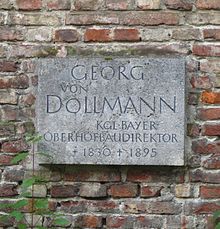Georg von Dollmann
Georg Carl Heinrich Dollmann , from 1875 Ritter von Dollmann , (born October 21, 1830 in Ansbach , † March 31, 1895 in Munich ) was a German architect and Bavarian construction clerk .
Life
The son of a civil servant attended grammar school in Ansbach and came to Munich in 1846, where he received his technical and artistic training at the Polytechnic School and the Academy of Fine Arts . His first building was the Stourdza Chapel in Baden-Baden . In 1854 he joined the Royal Bavarian State Railways . As a district engineer in the construction department, he was involved in the design of high-rise railway structures, for example the renovation of the train station in Gemünden am Main . Leo von Klenze made him his assistant, in whose office he worked until Klenze's death in 1864.
Dollmann completed the Liberation Hall and expanded the Assyrian Hall in the courtyard of the Glyptothek . His first major independent work was the neo-Gothic parish church Heilig Kreuz in Giesing , which was built from 1866 to 1883.
He also designed Seeseiten Castle on Lake Starnberg , which was built in 1866/67.
After he had already designed a magnificent, unfinished building on behalf of King Max II , he entered the service of King Ludwig II as an architect in 1868 . Under him he quickly rose to the position of Hofrat, Hofbau-Intendanzrat and Hofbaudirektor. In 1875 he was awarded the Order of Merit of the Bavarian Crown and thus the elevation to personal nobility.
In 1869/70 he designed the project of a Byzantine palace for the king in five different planning stages, but this was not realized. Between 1870 and 1872 he expanded the hunting lodge in Linderhof with a U-shaped building complex, in the center of which was the parade bedroom. Between 1874 and 1879, this complex was expanded to form today's Linderhof Palace and the hunting lodge was moved. From 1868 onwards, Ludwig II von Dollmann had a project for a new Palace of Versailles in the Linderhof valley planned under the code name Meicost-Ettal . From December 1868 to September 1873, Dollmann presented thirteen different floor plan variants as well as numerous elevations and many views for the bedroom. The project was then transferred to Herreninsel in Chiemsee from 1873 . The new Herrenchiemsee Palace there remained unfinished.
The royal house on Schachen , a wooden frame construction, was built from 1869 to 1872. In 1874, Dollmann took over from Eduard Riedl the management of the construction work for Neuschwanstein Castle , the foundation stone of which was laid in 1869.
In 1884, Dollmann fell out of favor with the king and had to give way to his colleague Julius Hofmann . Dollmann has lived in retirement since then. His wife Eugenie Félicité Sophie Dollmann, a granddaughter of Klenze, died shortly before him at the end of 1894.
tomb
The tomb of Georg Dollmann is located on the old southern cemetery in Munich (New Arkadenplatz 112 at cemetery 42) location .
literature
- Hyacinth Holland : Dollmann, Georg von . In: Allgemeine Deutsche Biographie (ADB). Volume 48, Duncker & Humblot, Leipzig 1904, p. 19 f.
- Herbert Brunner: Dollmann, Georg von. In: New German Biography (NDB). Volume 4, Duncker & Humblot, Berlin 1959, ISBN 3-428-00185-0 , p. 63 f. ( Digitized version ).
- Marcus Spangenberg: Linderhof. Buildings and dreams in the mountains. Verlag Friedrich Pustet, Regensburg 2018, ISBN 978-3791728049 .
Individual evidence
- ^ Meyer's Large Conversational Lexicon . 6th edition. Bibliographisches Institut, Leipzig / Vienna 1909 ( zeno.org [accessed on October 8, 2019] Lexicon entry "Dollmann").
| personal data | |
|---|---|
| SURNAME | Dollmann, Georg von |
| ALTERNATIVE NAMES | Dollmann, Georg Carl Heinrich Ritter von (full name); Dollmann, Georg Carl Heinrich; Dollmann, Georg |
| BRIEF DESCRIPTION | German architect and construction officer |
| DATE OF BIRTH | October 21, 1830 |
| PLACE OF BIRTH | Ansbach |
| DATE OF DEATH | March 31, 1895 |
| Place of death | Munich |


